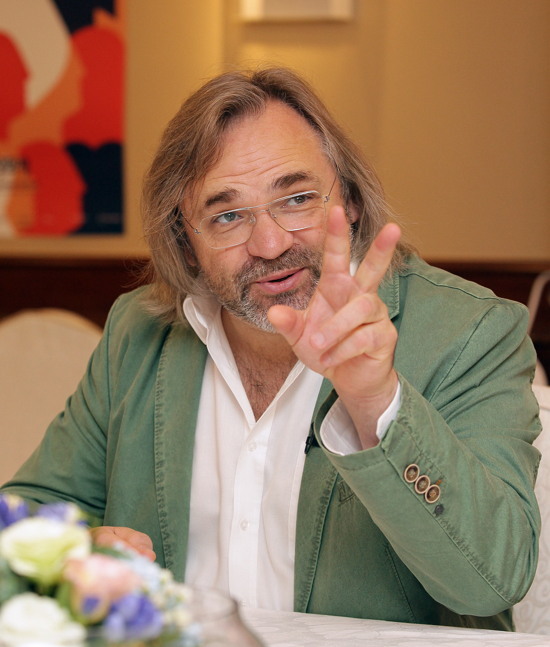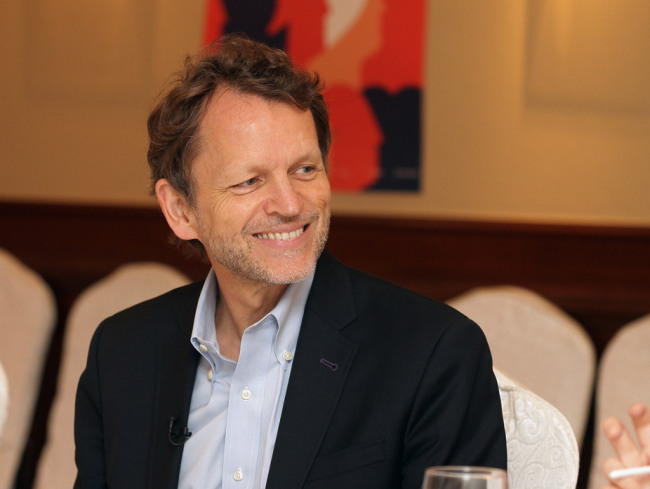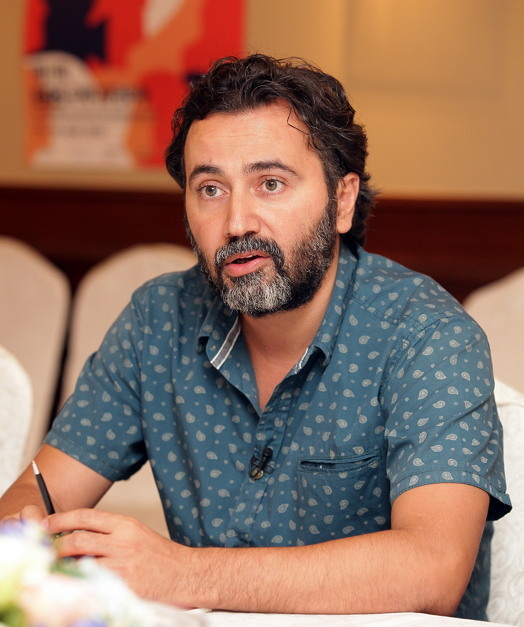[Herald Interview] Searching for meaning through documentaries
EIDF judges and filmmaker share their food for thought on documentaries
By Korea HeraldPublished : Aug. 31, 2014 - 20:42
An international documentary festival was held last week in Seoul, bringing filmmakers, documentary fans and producers together under the theme of “hope lies within us.”
The 11th EBS International Documentary Festival, which screened presentations in theaters and on TV at the same time, featured over 50 documentaries from 23 countries for seven days.
Among the participants at this year’s edition, head judge Victor Kossakovsky, judge David Royle from Smithsonian Channel and director Talal Derki held a group interview with The Korea Herald and other local news media during the festival to talk about their documentary careers and the most important factors in making a film that provides meaning and hope to audiences.
Victor Kossakovsky: Intuition to pinpoint the changing corners of life
As head judge, Russian filmmaker Victor Kossakovsky strongly adheres to the belief that any big artists have two roles in society.
“The first is to give a signal to what is happening within society,” said Kossakovsky. “And the second is to understand the issues and guide what people need to see.”
This ability does not come from knowledge, according to Kossakovsky.
“It is mere instinct.”
For the veteran filmmaker, who has won more than 100 awards at domestic and international festivals, turning on one’s instinct and intuition in a timely fashion is critical. “Filmmakers have to always know what will happen next.”
The 11th EBS International Documentary Festival, which screened presentations in theaters and on TV at the same time, featured over 50 documentaries from 23 countries for seven days.
Among the participants at this year’s edition, head judge Victor Kossakovsky, judge David Royle from Smithsonian Channel and director Talal Derki held a group interview with The Korea Herald and other local news media during the festival to talk about their documentary careers and the most important factors in making a film that provides meaning and hope to audiences.
Victor Kossakovsky: Intuition to pinpoint the changing corners of life
As head judge, Russian filmmaker Victor Kossakovsky strongly adheres to the belief that any big artists have two roles in society.
“The first is to give a signal to what is happening within society,” said Kossakovsky. “And the second is to understand the issues and guide what people need to see.”
This ability does not come from knowledge, according to Kossakovsky.
“It is mere instinct.”
For the veteran filmmaker, who has won more than 100 awards at domestic and international festivals, turning on one’s instinct and intuition in a timely fashion is critical. “Filmmakers have to always know what will happen next.”

“We have to use different parts of our body, parts of our hearts, eyes and ears to be at the moment where things break out. The most important thing is to exactly know where to be stationed with the camera.”
Not everyone has that ability from the outset, the director said. “That’s why you need to study and practice a lot while experiencing as much as possible.”
When asked whether Kossakovsky would judge the films at the festival based on instinct, he answered, “A festival is an exhibition of art.” He said he would not judge professionalism, but rather put weight on the artistic and unique qualities of the films.
“Good films have three qualities. First is the filmmaker’s own unique style, second is having an interesting and charismatic character and last is an unforgettable narrative,” replied Kossakovsky. “But these three elements are not enough ― they need magic and miracles. Each film has to have something people cannot predict and surprise the audience.”
“That’s why you have to be open for surprises,” he continued. “Good stories derive from uncertainty. If I know the ending to the story already, I can’t film the picture with a variety of colors.”
For this reason, Kossakovsky sees himself as an “observer” of the world who analyzes according to what life gives him. “The fact that what happens the next minute is uncertain is what makes me happy,” the director said.
David Royle: Balancing between credibility and entertainment
Judge David Royle, the person in charge of overseeing the commissioning, producing, acquiring and scheduling for the acclaimed Smithsonian Channel, believes documentaries should diffuse knowledge as they entertain the audience, but at the same time should have high credibility to impart information to audiences.
“Documentaries have to become smart entertainment,” said Royle. “We know that documentaries can be indulgent, a little bit overly long, and sometimes lack discipline of storytelling. But when they are well done, there are more stories in everyday life than drama or fiction, just like how people say ‘life is stranger than fiction.’”

Royle, who has received a number of awards including an Emmy, says his goal with the channel is to tell stories about real life infused with drama that is richly detailed and visually compelling. But he admits that “balancing between entertainment and nonfictional aspect of a documentary is always challenging.
“Many nonfiction channels in the U.S. have turned into reality channels, doing programs that are character-led to a certain extent that is fabricated,” said Royle. “But we try our best to show real life without creating the environment. And through these real-life (presentations), audiences have takeaway (lessons on) human nature and understanding of the real world.”
He admits that there has been an explosion of nonfiction channels because it is people’s natural tendency to try to understand world events and what is behind them. But with the advancement of technology, audiences expect higher-quality content. “We had to find new ways to engage with the audiences,” said Royle.
“It is the case in Korea, where people want to watch shows not only on TV but on their sub-devices,” said Royle. “We have been very proactive in mobile apps, and developed other multimedia platforms for audiences to participate and engage as well.”
For example, when the channel did a film about the “Hope Diamond,” a 45.52-carat diamond housed in the Smithsonian Natural History Museum in Washington, D.C., the production added a section where audience members could vote for the design of the necklace for the diamond.
“It is these kinds of activities that trigger the audience’s participation and engagement, making the nonfiction genre more interesting and entertaining,” said Royle.
Talal Derki: Documentary to deliver human emotion to the story
Syrian filmmaker Talal Derki is one of only a few filmmakers who were brave enough to jump with a camera into the city of Homs, Syria, a harrowing battlefield of the ongoing Syrian Civil War, in August 2011.
“The year 2011 was the beginning of the Arab Spring, when the revolution was taking place,” said Derki. “I worked as a video reporter for international outlets, such as CNN and Reuters, covering the Syrian uprising, from images of bombed-out buildings, blood-spattered city to besieged citizens.”

As Derki was reporting on the scene, he wanted to capture what journalists weren’t able to because of the increasing difficulty of reporting inside Syria. “If you have a little bit of courage, you had to say what was happening inside the country,” said Derki. “This was the time for a documentary to tell part of the story, the story that only the strong people and winner gets to write.”
This is how the documentary “Return to Homs” was filmed for two years until Aug. 2013, capturing the Syrian conflict through the eyes of Bassett, a 19-year-old goalkeeper for the national soccer team, who led protests against President Bashar al-Assad’s government.
“When the revolution began, every Syrian … was part of it,” he said. Regardless of peoples’ positions, “everyone’s life has changed. What I wanted to discover was what has changed for the people. As a filmmaker, I wanted to talk about the human story of the crisis.”
In the film, there is a scene where Bassett looks out on the city through a hole of the wall inside his house. The city is totally destroyed and Bassett comments, “This is Homs but I don’t know where I am.”
“Just like how the film shows a stark contrast from motivated Bassett during the protest to his inner pain and loneliness when he is by himself, the film solely focuses on human emotions in order to deliver the message.”
“This movie, therefore, is a war film, but also against the war,” said Derki.
Derki, who risked his life many times to film the documentary, says filming in Syria is almost like suicide. But he is planning to film another film on his motherland, even if that means working under another alias or using an assortment of digital cameras including a Handycam, to immerse himself in the world he is documenting.
By Ahn Sung-mi (sahn@heraldcorp.com)
-
Articles by Korea Herald








![[Kim Seong-kon] Democracy and the future of South Korea](http://res.heraldm.com/phpwas/restmb_idxmake.php?idx=644&simg=/content/image/2024/04/16/20240416050802_0.jpg&u=)








![[KH Explains] Hyundai's full hybrid edge to pay off amid slow transition to pure EVs](http://res.heraldm.com/phpwas/restmb_idxmake.php?idx=652&simg=/content/image/2024/04/18/20240418050645_0.jpg&u=20240418181020)

![[Today’s K-pop] Zico drops snippet of collaboration with Jennie](http://res.heraldm.com/phpwas/restmb_idxmake.php?idx=642&simg=/content/image/2024/04/18/20240418050702_0.jpg&u=)